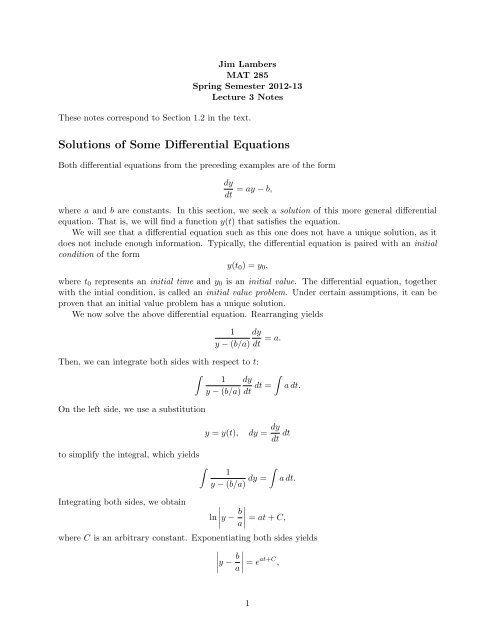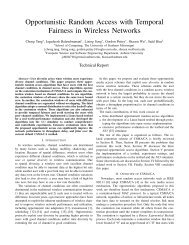Solutions of Some Differential Equations
Solutions of Some Differential Equations
Solutions of Some Differential Equations
Create successful ePaper yourself
Turn your PDF publications into a flip-book with our unique Google optimized e-Paper software.
Jim LambersMAT 285Spring Semester 2012-13Lecture 3 NotesThese notes correspond to Section 1.2 in the text.<strong>Solutions</strong> <strong>of</strong> <strong>Some</strong> <strong>Differential</strong> <strong>Equations</strong>Both differential equations from the preceding examples are <strong>of</strong> the formdydt= ay − b,where a and b are constants. In this section, we seek a solution <strong>of</strong> this more general differentialequation. That is, we will find a function y(t) that satisfies the equation.We will see that a differential equation such as this one does not have a unique solution, as itdoes not include enough information. Typically, the differential equation is paired with an initialcondition <strong>of</strong> the formy(t 0 ) = y 0 ,where t 0 represents an initial time and y 0 is an initial value. The differential equation, togetherwith the intial condition, is called an initial value problem. Under certain assumptions, it can beproven that an initial value problem has a unique solution.We now solve the above differential equation. Rearranging yields1 dyy − (b/a) dt = a.Then, we can integrate both sides with respect to t:∫∫1 dyy − (b/a) dt dt =a dt.On the left side, we use a substitutionto simplify the integral, which yields∫y = y(t),dy = dydt dt∫1y − (b/a) dy =a dt.Integrating both sides, we obtainln∣ y − b a∣ = at + C,where C is an arbitrary constant. Exponentiating both sides yields∣ y − b a∣ = eat+C ,1
which can be rearranged to obtainy = b a + ceat ,where c = ±e C .This solution is known as the general solution. It is a function <strong>of</strong> the independent variable tas well as the parameter c, the value <strong>of</strong> which depends on the initial condition. Thus, the generalsolution consists <strong>of</strong> infinitely many curves, each one being the graph <strong>of</strong> a function <strong>of</strong> t correspondingto a different value <strong>of</strong> c. Each such curve is called an integral curve.We now use the general solution to obtain the solution <strong>of</strong> the initial value problem. Substitutingthe initial condition into the general solution, we haveWe then solve this equation for c to obtainc =y 0 = b a + ceat 0.(y 0 − b )e −at 0.aSubstituting this expression for c into the general solution yields the solution <strong>of</strong> the inital valueproblem,y = b (a + y 0 − b )e a(t−t0) .aExample We revisit the equationdvdt = 9.8 − v 5 .This is an equation <strong>of</strong> the form dy/dt = ay − b, with y = v, a = −1/5 and b = −9.8. Applying theabove formula for the general solution yieldsv(t) = 49 + ce −t/5 ,where c is an arbitrary constant. Now, if we add the initial condition v(0) = 50, we obtain theunique solutionv(t) = 49 + (50 − 49)e −(t−0)/5 = 49 + e −t/5 .✷2
















